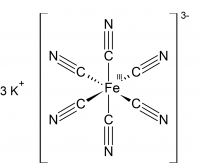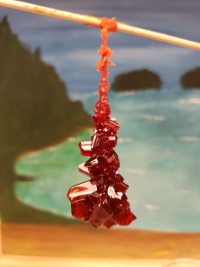Difference between revisions of "Ferricyanide Crystal"
Jump to navigation
Jump to search
| Line 1: | Line 1: | ||
[http://esr.monmsci.net/wiki/index.php/Growing_Crystals back to Crystal Growing...] | [http://esr.monmsci.net/wiki/index.php/Growing_Crystals back to Crystal Growing...] | ||
| + | |||
| + | ==Structure== | ||
| + | [[File:Structure_of_potassium_ferricyanide.png|thumb|right|200px|The structure of potassium ferricyanide]] | ||
| + | |||
| + | The structure of potassium ferricyanide consists of an iron molecule octahedrally coordinated by six cyanide ligands. | ||
| + | ==General Information== | ||
| + | *Molecular Weight: 329.24 g/mol | ||
| + | *Appearancy: Red crystalline solid | ||
| + | *Melting Point: 300°C | ||
| + | *Density: 1.89 g/cm<sup>3</sup> | ||
| + | *Crystal Structure:[https://en.wikipedia.org/wiki/Monoclinic_crystal_system Monoclinic] | ||
| + | |||
| + | ==Safety== | ||
| + | *When exposed to HCl, potassium ferricyanide forms hydrogen cyanide gas which is an asphyxiant and can be fatal. | ||
| + | *Potassium ferricyanide is not very toxic, but can stain. | ||
| + | |||
==General Procedure== | ==General Procedure== | ||
The most general way to grow a crystal includes forming a supersaturated solution by heating up water and adding in the crystal medium, here I used Potassium Ferricyanide, until is doesn't dissolve anymore. | The most general way to grow a crystal includes forming a supersaturated solution by heating up water and adding in the crystal medium, here I used Potassium Ferricyanide, until is doesn't dissolve anymore. | ||
For a general procedure, the following link can be used: [https://sciencenotes.org/grow-natural-bright-red-potassium-ferricyanide-crystals/ How to Grow a Potassium Ferricyanide Crystal] | For a general procedure, the following link can be used: [https://sciencenotes.org/grow-natural-bright-red-potassium-ferricyanide-crystals/ How to Grow a Potassium Ferricyanide Crystal] | ||
| + | |||
| + | [[File:20190407_133643.jpg|thumb|right| 200px| A picture of the potassium ferricyanide crystal grown by Seth Croslow]] | ||
The following is the procedure that I followed: | The following is the procedure that I followed: | ||
| Line 12: | Line 30: | ||
# Cover the finished solution with something(a watchglass or parafilm) and let it sit overnight. | # Cover the finished solution with something(a watchglass or parafilm) and let it sit overnight. | ||
| − | |||
| − | |||
| − | |||
| − | |||
Note: Another way to do this would be to make a saturated solution and allow the water to evaporate slowly over time. This may yield a single large crystal instead of a conglomerate of smaller crystals, although it will take significantly longer. | Note: Another way to do this would be to make a saturated solution and allow the water to evaporate slowly over time. This may yield a single large crystal instead of a conglomerate of smaller crystals, although it will take significantly longer. | ||
Revision as of 23:47, 24 April 2019
Structure
The structure of potassium ferricyanide consists of an iron molecule octahedrally coordinated by six cyanide ligands.
General Information
- Molecular Weight: 329.24 g/mol
- Appearancy: Red crystalline solid
- Melting Point: 300°C
- Density: 1.89 g/cm3
- Crystal Structure:Monoclinic
Safety
- When exposed to HCl, potassium ferricyanide forms hydrogen cyanide gas which is an asphyxiant and can be fatal.
- Potassium ferricyanide is not very toxic, but can stain.
General Procedure
The most general way to grow a crystal includes forming a supersaturated solution by heating up water and adding in the crystal medium, here I used Potassium Ferricyanide, until is doesn't dissolve anymore.
For a general procedure, the following link can be used: How to Grow a Potassium Ferricyanide Crystal
The following is the procedure that I followed:
- Obtain potassium ferricyanide, a 250 mL beaker, a stirplate/hotplate, and a stirbar.
- Begin heating up the water on the hotplate and add the stirbar.
- Once hot, begin adding the potassium ferricyanide (It will take some time for it to dissolve, but it eventually will).
- Keep adding until the rate of dissolution decreases( The article above mentions to use about 93g in 200mL of water).
- Cover the finished solution with something(a watchglass or parafilm) and let it sit overnight.
Note: Another way to do this would be to make a saturated solution and allow the water to evaporate slowly over time. This may yield a single large crystal instead of a conglomerate of smaller crystals, although it will take significantly longer.

